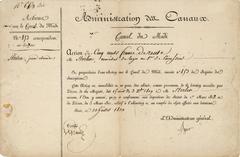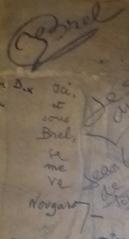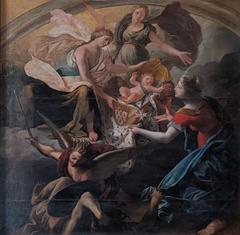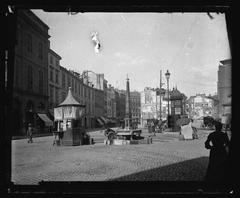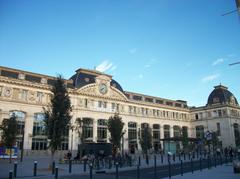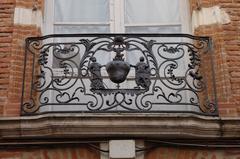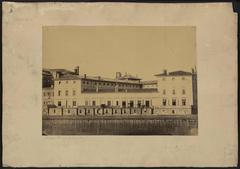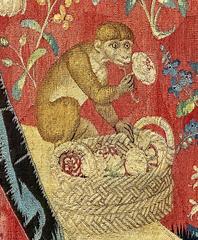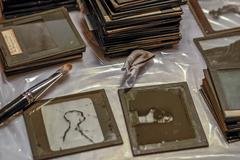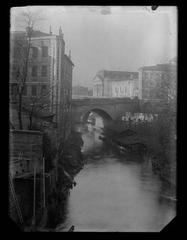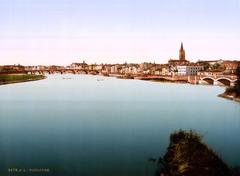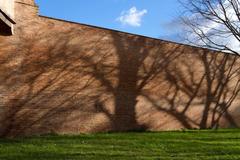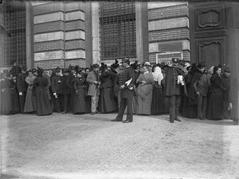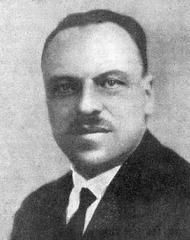Visiting Hôtel D’Andrieu De Montcalvel, Toulouse, France: Tickets, Hours, and Essential Tips
Date: 03/07/2025
Introduction
The Hôtel d’Andrieu de Montcalvel, situated at 10 rue Croix-Baragnon in the heart of Toulouse, is a striking example of the city’s architectural and aristocratic past. This grand hôtel particulier, with its distinctive pink terracotta brick façade and monumental entrance, encapsulates centuries of Toulouse’s urban evolution—from its Renaissance mercantile power to its present-day vibrancy. While generally closed to the public, the hôtel opens for special events such as the European Heritage Days, offering a rare glimpse into its historic splendor (Société Archéologique du Midi de la France, 2016; POP: la plateforme ouverte du patrimoine; Toulouse Tourism). This guide provides a detailed overview of its history, architecture, heritage status, and practical information for visitors.
Table of Contents
- Introduction
- Origins and Historical Context
- Architectural Features
- Ownership and Heritage Status
- Visitor Information: Hours, Tickets, and Accessibility
- Nearby Attractions and Travel Tips
- Cultural Significance
- FAQs
- Visuals and Multimedia
- Conclusion
- Call to Action
- References
Origins and Historical Context
The Hôtel d’Andrieu de Montcalvel traces its roots to the late 15th century, originally known as the Hôtel Dufaur de Saint-Jory, a residence of Toulouse’s parliamentarian elite (Société Archéologique du Midi de la France, 2016). The prosperity of Toulouse in this era, fueled by the lucrative pastel (woad) trade, inspired the construction of grand urban mansions by the city’s wealthy families (Toulouse Tourism: History & Monuments).
In 1770, François-Joseph d’Andrieu de Montcalvel acquired the property, demolishing the existing medieval structure to build a new neoclassical mansion, reflecting the Enlightenment’s ideals of symmetry, proportion, and restrained decoration (Société Archéologique du Midi de la France, 2016). This transformation marked the hôtel as a symbol of social distinction and modernity in the late 18th century.
Architectural Features
Exterior & Urban Setting
The Hôtel d’Andrieu de Montcalvel’s façade is emblematic of Toulouse’s “Ville Rose” identity, constructed with the city’s characteristic pink terracotta brick. Its monumental portal, designed as a triumphal arch adorned with double Ionic pilasters and crowned by a terracotta group of lions and martial trophies, is among the city’s architectural highlights (Monumentum). This portal, recently restored, is a rare example of monumental terracotta sculpture in Toulouse (Kansei TV).
The mansion is arranged around a rectangular cour d’honneur, a layout typical of Toulouse’s grand residences, providing both privacy and a sense of grandeur. The exterior features elegant stone detailing and finely wrought-iron balconies, restored by local artisans (Kansei TV).
Interior & Decorative Arts
Inside, the hôtel boasts a grand staircase with an ornate wrought-iron balustrade, attributed to master ironworkers Joseph Bosc and possibly Ortet (Société Archéologique du Midi de la France, 2016). The apartments retain marble fireplaces, stucco ornamentation, and period woodwork in the Louis XVI style. Some decorative elements, like carved beams, were recycled from the original medieval structure, testifying to both the resourcefulness and heritage-consciousness of its owners.
Ownership and Heritage Status
The property has changed hands among several prominent families, reflected in its alternate names: Hôtel de Castellane, Hôtel de Campaigno, and Hôtel de Saint-Jory. In 1847, Mayor Jean Patras de Campaigno modernized the property, adding gas lighting and updating the interiors.
The hôtel is a protected Monument Historique, with its façades, roofs, entrance portal, courtyards, passages, and ironwork all listed in the French inventory of historic monuments (POP: la plateforme ouverte du patrimoine). This legal status ensures preservation and recognition of its historical and artistic value.
Visitor Information: Hours, Tickets, and Accessibility
- Regular Access: The Hôtel d’Andrieu de Montcalvel is privately owned and not open for regular public visits. Exterior viewing is possible at any time from the street.
- Special Openings: During the European Heritage Days (Journées Européennes du Patrimoine), typically in September, guided tours may be offered. Entry is usually free, but check with the Toulouse Tourist Office for details and bookings.
- Accessibility: The site’s historic nature may restrict accessibility for visitors with mobility challenges. Exterior areas are accessible from the street.
- Guided Walks: The mansion is a highlight on many heritage walks through Toulouse’s historic center.
Nearby Attractions and Travel Tips
The hôtel’s central location makes it a perfect starting point for exploring Toulouse’s historic core. Nearby must-sees include:
- Place du Capitole: The city’s main square with the Capitole building and lively cafés (World Travel Guide).
- Basilique Saint-Sernin: UNESCO-listed Romanesque basilica (The Crazy Tourist).
- Musée des Augustins: Fine arts museum in a former Gothic monastery.
- Hôtel d’Assézat: Another renowned hôtel particulier and art museum.
- Rue Saint-Rome and Rue des Arts: Bustling shopping and dining streets.
Travel Tip: Combine your visit with a heritage walk along rue Croix-Baragnon and nearby landmarks for a comprehensive experience.
Cultural Significance
The Hôtel d’Andrieu de Montcalvel is not merely an architectural gem but also a reflection of Toulouse’s social and cultural history. Its construction and evolution mirror the fortunes of the city’s elite, the transition from medieval to neoclassical styles, and the enduring importance of heritage preservation in Toulouse’s urban identity (Toulouse Tourism: History & Monuments).
Frequently Asked Questions (FAQ)
Q: Can I visit the interior of Hôtel d’Andrieu de Montcalvel?
A: No, the interior is not open to the public except during rare heritage events.
Q: Are there tickets required?
A: No regular ticketing. Entry during special events is often free; check ahead for details.
Q: Are guided tours available?
A: Yes, during heritage days and through some historic city walking tours.
Q: How do I get there?
A: The hôtel is centrally located on rue Croix-Baragnon, a short walk from Capitole and Esquirol metro stations.
Q: Is the building accessible for those with limited mobility?
A: Exterior viewing is accessible; interior access may be limited during special events.
Visuals and Multimedia
- Image Suggestions:
- Facade with pink brick and monumental portal (alt: “Hôtel d’Andrieu de Montcalvel pink brick façade, Toulouse”).
- Close-up of the wrought-iron staircase balustrade (alt: “Wrought-iron balustrade, Hôtel d’Andrieu de Montcalvel staircase”).
- Map of the historic center showing the hôtel’s location.
- Media Tips:
- Interactive maps and virtual tours can enhance the visitor experience.
Conclusion
The Hôtel d’Andrieu de Montcalvel stands as a testament to Toulouse’s aristocratic legacy and architectural mastery. Though access is limited, its striking façade and rich history make it a landmark for any exploration of the city’s heritage. Plan your visit during the European Heritage Days or join a guided tour to experience Toulouse’s storied past firsthand.
Call to Action
Stay informed about heritage events and guided visits by checking the official Toulouse tourism website. For more in-depth guided experiences and personalized travel tips, download the Audiala app and follow us on social media.
References
- POP: la plateforme ouverte du patrimoine
- Société Archéologique du Midi de la France, 2016
- Toulouse Tourism: History & Monuments
- Kansei TV
- Toulouse Tourism
- World Travel Guide
- The Crazy Tourist

